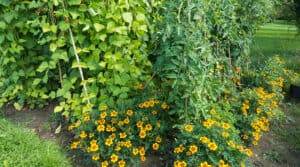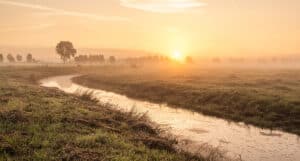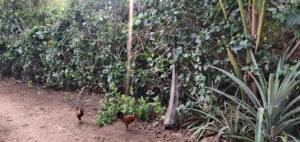If you start delving into the process of permaculture design for land, ‘sectors’ is a word that will soon come up. If you have never encountered this term before, you may be confused and understanding sectors will be at the top of your agenda as you seek to continue on your permaculture journey.
In this guide, I plan to cover the basics to help you understand what sectors are, and how observing and interacting with them can help us to develop strategies for a space.
When a permaculture designer starts to think about designing a garden, they do not start with aesthetic considerations or specific plants. Rather, they look at the site carefully, thinking about the things that make it the way it is, and the various different factors which act upon the site.
This might sound a little complex, but really, all this involves is observation, and an understanding of the environment around us.
Permaculture is not an approach which offers ‘one size fits all’ solutions. All the choices we make in design and in gardening should be site specific. By observing the site and making careful note of key features, opportunities, resources and constraints, we can begin to build up a clear picture that forms the foundation of good design.
Analysing the site means understanding the geographic positioning, topography and climate of the area, and developing a sense of the microclimate of the specific location. Permaculture designers will take a close look at each of the above, in order to develop a deep understanding of the specific place.
As well as looking closely at the site itself, developing a clear view of the site means building an understanding of things that act on the environment from the outside.
What are Sectors in Permaculture Design?

Sectors are the natural patterns of energy flow in a given location – factors that affect the environment from outside its boundaries.
Sectors are all about flow – movement – the patterns that are created. We look at how these things influence the site, how opportunities can be harnessed and constraints overcome. Often, this understanding helps us see how to turn problems into solutions.
Key sectors to consider are:
- Sunlight
- Water
- Wind
Other external directional forces (outwith our immediate control) may also influence our designs. We might also look, for example, at:
- Wildfire Risk
- Pollution
- Wildlife
- People
Key Sectors in Permaculture Design
Sunlight, wind and water are of course among the most important things to consider when you are in the observation phase of permaculture design for any site.
- Sunlight
Of course, sunlight is one of the most important external forces acting on a site. The amount of sunlight available, and the direction from which it comes throughout each day and throughout the year is hugely important in determining how the site is best utilised, laid out and planted.
In permaculture, one of our key objectives is to make the most of the sun – maximising photosynthesis, of course, and also thinking how best to make use of the sun’s energy in a range of different ways.
Sun is of course often a beneficial factor. But it is important to remember that shade can be important and beneficial too. Sometimes, maximizing shade can also be important in reducing the impact of hot, drying sun during certain times of the day and the year.
In order to make the most of the sunlight on a site, we need to find out where the sun will be at any given time on any given day in any given location. We can do so simply by observing the natural cycles throughout the year. However, since we cannot always spare the time to simply watch and wait for an entire year, we can consult online sun position charts such as https://www.suncalc.org to gain this vital information.
We can also collect information from observation and create sun maps to refer to throughout the year. A sun map is basically a pictorial representation of the movement of the sun, and the shade cast. A sun map might be a simple rough sketch, or a far more complex and detailed document.
It might depict the movement of the sun over the course of a day at a certain time of year. And may also include more information about how this changes as the sun moves across the sky throughout the course of the year.
Once a sun map has been created, it will be easy to see whether a particular part of a site has full sun, partial shade, or deep shade. We can determine which parts of the garden have the most hours of sunlight per day, and which areas have the least. And know when the sunlight is received in each part of the site.
This is of course crucial in order for us to choose the right plants for the right places. But it can also be important for the overall design of a site in a range of other ways.
- Water
Water and how it moves across the site is also a key thing considered in sector analysis. We need to consider, of course, the rainfall in a particular area. But also how, due to topographical and other details, it flows on, over, across and through the site.
Hydrology is, of course, closely linked to climate and geography, as well as to the soil on a site and the life-forms found there. Looking at water availability and water flow on a site is crucial to developing a truly sustainable and sensitive holistic design.
Water is of course essential for life. But it can be a destructive force too. Mapping this sector helps us to make sure we can catch and store water and use it wisely. It can also help us mitigate flood risk etc. in areas where this may be a concern.
If you do not have a stream or watercourse running across your intended site, you may be wondering whether water flow is relevant to you. But of course water flow is not always of the visible variety. Even where you cannot see it, water will still make its way across any site, following the natural laws of physics. Often, it will simply be below the soil.
The first thing to remember is that water always flows downhill. This may seem painfully obvious. But is surprising how often simple things like this are forgotten.
- Wind
Wind is another important sector to consider. Determining and mapping prevailing wind direction, and thinking about the direction, strength and characteristics of wind throughout the year also helps us to identify opportunities and challenges.
Wind might be a positive element – utilised to generate renewable energy, to provide passive cooling, or to dry clothes, for example.
We might also have to take steps in a design to mitigate against the effects of a cold or drying wind – by creating windbreak hedging or shelter belts on specific parts of a site, for example.
Understanding typical wind patterns for a site can help us develop the best strategies to harness that energy, and to protect people, planting and other elements from it.
Other Directional Forces in Permaculture Design
Observing and understanding a particular site also involves looking at other directional forces, both positive and negative.
- Wildfire Risk
Wind, along with topographical factors and surrounding vegetation, is also an important factor in helping us to identify and map wildfire risk.
By looking holistically at the landscape and its flows, we can map the direction of wildfire risk and use that to make sure we do all we can to design for fire safety.
- Pollution
Wind and water might also play a role in helping us determine the directional forces of pollution – from nearby factories, farms, or busy roads, for example.
Boundary planting and other strategies can help us to reduce its impact on the site. We can also consider other types of ‘pollution’ – visual pollution – unsightly views; and auditory (sound) pollution, for example.
- Wildlife
In sector analysis, it can also be helpful to map the broader patterns of wildlife within the area.
By taking note of migratory patterns and wildlife corridors, for example, we can help in reducing biodiversity losses and make sure that the site works within the whole to safeguard all those non-human beings who visit and pass through.
We can also think about protecting food producing systems from foraging and pest species that may pass through. For example, if a site has woodland to a particular side, risk from deer or even predators may be most likely to come from that direction.
- People
People also have to be taken into account. Not only the people associated with or using the site itself but also the broader societal systems and communities which can be forces acting on the site and its inhabitants.
Understanding the bigger picture in human as well as landscape terms can be key to good design. Considering the neighbours, the community, and the broader socio-economic and political environment is key.
People may impinge upon a given site in negative ways. Or be a boon, and a resource that can be beneficial within a design. Patterns of human movement can impact a site and its design in a range of different ways. And we should always think about how people will use and interact with their environment.
Identifying Strengths, Weaknesses, Opportunities and Challenges
In permaculture design, there are various ways to create a framework that will inform our decisions. One commonly used idea is SWOC analysis, which involves, after we map sectors, listing the strengths, weaknesses, opportunities and challenges of the site and situation.
Within permaculture design, by mapping positives and negatives in this way, we can begin to see the reality of a situation, and can soon see that what we may at first view as a challenge can in fact be an opportunity, what might seem a weakness can, through good design, be turned into a strength.
For example, a shaded site might seem like a challenge. But it could provide opportunity to create a growing system that embraces shade-tolerant planting. It might be a location where moisture is more easily maintained. And it could offer opportunities to explore fungi cultivation, for example.
A site with high rainfall and high water table may be prone to flooding. But careful management of the water present might provide excellent opportunities to catch, store and utilise the abundant water resource.
There are of course plenty of further examples. Through analysing sectors and getting to know a site, the process of permaculture design can help us to see the strengths and opportunities of any site and situation.
Moving From Patterns to Details
One key permaculture principle is that we should move from patterns to details. We should start with an appreciation of the big picture before we hone in on any specifics, and sectors analysis is a big part of this initial phase.
The patterns of sunlight, water and wind on a property in particular will be crucial in shaping our understanding of a site, directing our analysis, helping us make our decisions and inspiring us in many ways that elevate our designs.
We may not only make practical decisions based on the sectors we see, but can also work in harmony with nature by mimicking natural patterns in the flows and movements acting on the site.
For example, in creating pathways for human movement through a site, we might mimic the branching paths taken by water through a landscape. We might be influenced by the parabolic path of the sun when deciding on the shape of growing areas…
Sectors are crucial in the patterns of permaculture, and are among the most important things to consider as we work through the initial phases of design.
Understanding sectors gives us the firm foundations we need to truly understand our sites and their patterns and flows, to identify strengths, weaknesses, opportunities and challenges, and to build resource maps for a given site and situation.







